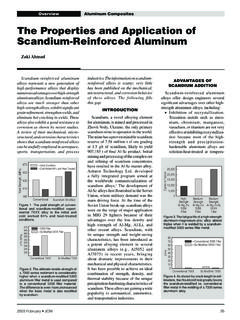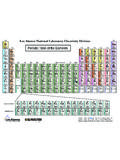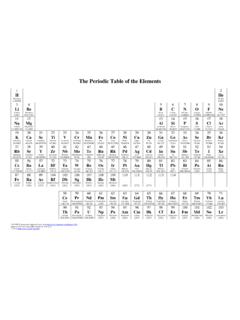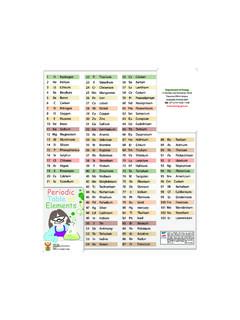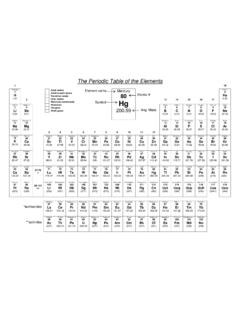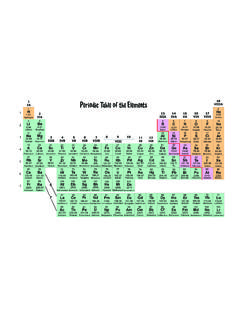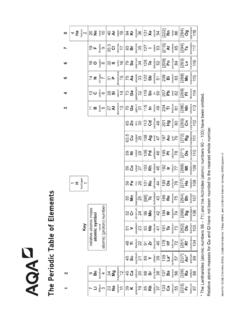Transcription of SCANDIUM
1 White Paper SCANDIUM A review of the element, its characteristics, and current and emerging commercial applications EMC Metals Corporation (TSX: ) 1430 Greg Street, Suite 501 Sparks, Nevada 89431 Authors: Willem P. C. Duyvesteyn (EMC) George F. Putnam (EMC) May 2014 Sc DISCLAIMER: This white paper is for informational purposes only, does not constitute an offer of securities and should not be relied upon in making a decision to invest in EMC Metals Corp. The white paper contains scientific, market and industry data based upon information from publicly available industry sources believed to be reliable, but no guarantee is made or implied as to the accuracy and completeness of the information. While EMC Metals Corp.
2 Believes this data to be reliable, market and industry data are subject to variations and cannot be verified with complete certainty. EMC Metals Corp. has not independently verified any of the data from third party sources contained herein. 2 Element Description (Sc) In 1879 a Swedish chemist Lars Fredrik Nilsson was looking for rare earth elements in the minerals euxenite and gadolinite when he discovered erbium and ytterbium; SCANDIUM was later separated from the ytterbium. While Mendeleev predicted an element ( ekaboron ) in SCANDIUM s location on his periodic chart in the late 1860 s, Nilsson was credited with the actual discovery of SCANDIUM . At that time these minerals had only been found in Scandinavia, and the element was named after the region. SCANDIUM is a soft, silvery-white metallic element with an atomic number 21, and is technically a light transition metal.
3 It does exhibit some characteristics that are similar to the rare-earth elements (lanthanides), and is often classified as a member of the REE group, along with yttrium. The smaller size of SCANDIUM s ion allows it to react chemically with elements like aluminum, magnesium and zirconium. SCANDIUM is not particularly rare---its occurrence in crustal rocks is around 22 ppm. This makes SCANDIUM generally more abundant than lead, mercury, and precious metals, and about the same as cobalt. Despite this fairly common, albeit dispersed occurrence, SCANDIUM rarely concentrates in nature. It does not selectively combine with the common ore-forming anions, so time and geologic forces only rarely form SCANDIUM concentrations over 100 ppm. SCANDIUM exists in nature in its oxide form, and tarnishes to pink or yellow. It is very difficult to reduce to its pure elemental state.
4 In fact, it was not isolated in pure form until 1937 and the first pound of pure elemental SCANDIUM metal was not produced until 1960. SCANDIUM in oxide form is referred to as scandia, or of course SCANDIUM oxide, and the chemical formula is Sc2O3. Geology SCANDIUM is widely dispersed in the lithosphere and forms solid solutions in over 100 minerals, most commonly as a trace constituent of ferromagnesian minerals. Concentrations in these minerals (amphibole-hornblende, pyroxene, and biotite) typically range from 5 to 100 parts per million equivalent Sc2O3. These minerals commonly occur in igneous rocks, basalt and gabbro. Enrichment of SCANDIUM also occurs in rare-earth minerals, wolframite, columbite, cassiterite, beryl, garnet, muscovite, and the aluminum phosphate minerals. Table 1 - Minerals Containing Elemental SCANDIUM Bazzite Be3(Sc,Al)2Si6O18 Cascandite Ca(Sc,Fe++)Si3O8(OH) Jervisite (Na,Ca,Fe++)(Sc,Mg,Fe++)Si2O6 Juonniite CaMgSc(PO4)2(OH) 4(H2O), Kolbeckite ScPO4 2(H2O) Magbasite KBa(Al,Sc)(Mg,Fe++)6Si6O20F2 Pretulite ScPO4 Scandiobabingtonite Ca2(Fe++,Mn)ScSi5O14(OH) Thortveitite (Sc,Y)2Si2O7 Titanowodginite Mn++(Ti,Ta,Sc)2O8 Heftetjernite ScTaO4 3 The known, independent, SCANDIUM mineral deposits are generally insignificant in size and grade, with certain notable exceptions in some of the lateritic clay resources found in Australia.
5 Sedimentary deposition can form large SCANDIUM resources, as can placer depositions, particularly if they contain euxenite, monazite or zircon. SCANDIUM can be found in much higher concentrations in thortveitite, euxenite, and gadolinite. These minerals tend to be found in pegmatite formations, and are rare. Most of today s SCANDIUM production tends to come as a byproduct of the leaching activity associated with production of other metals, minerals, or rare earths, specifically U, Th, Al, W, Sn, Ta, P and REE s. Some SCANDIUM production has also been generated from the SCANDIUM -yttrium silicate mineral, thortveitite. The principal Sc-producing countries today are China, Russia, Ukraine, and Kazakhstan. In the US, the fluorite tailings from the Crystal Mountain deposit near Darby, MT., are known to contain thortveitite and associated SCANDIUM -enriched minerals.
6 Smaller SCANDIUM resources are contained in tungsten, molybdenum, and titanium minerals from the Climax molybdenum deposit in Colorado. Other lower grade domestic resources are present in ores of aluminum, cobalt, iron, molybdenum, nickel, phosphate, tantalum, tin, titanium, zinc, and zirconium. Process residues from certain historic tungsten operations in the United States also contain significant amounts of SCANDIUM . Foreign resources are known in Australia, China, Kazakhstan, Madagascar, Norway, Russia, and Ukraine. Resources in Australia are contained in nickel and cobalt resources in New South Wales. China s resources are in tin, tungsten, and iron deposits in Jiangxi, Guangxi, Guangdong, Fujian, and Zhejian Provinces, and is currently produced at Bayan Obo, the REE deposit in Inner Mongolia. Resources in Russia and Kazakhstan are found in certain uranium-bearing deposits, and on the Kola Peninsula in apatites.
7 In the Ukraine, SCANDIUM was previously recovered as a byproduct of iron ore processing at Zheltye Voda. SCANDIUM in Madagascar and Norway is typically found in pegmatite formations containing thortveitite. One other potentially significant SCANDIUM resource is the red mud tailings from the Bayer process, employed in bauxite processing into alumina. Red mud tailings typically contain 50-110 ppm Sc, but certain locations show concentrations of 150 ppm, depending on the ore type and precise process route. The processes that essentially double the original concentration of SCANDIUM (typically 30-50 ppm) also concentrate numerous other metals, specifically iron, aluminum and titanium, which are energy and process intensive to separate from SCANDIUM . Consequently, SCANDIUM recovery from these environmental legacy residues can be problematic, both as to environmental issues and cost.
8 General SCANDIUM Applications Principal uses for SCANDIUM are in solid oxide fuel cells (SOFC s), high-strength aluminum alloys, high-intensity metal halide lamps, electronics, and laser research. Solid Oxide Fuel Cells (SOFC s) Scandia can substitute for yttria as a stabilizing agent for the solid electrolyte (typically zirconia) in the fuel cell. The substitution allows reactions to occur at lower temperatures, extending the life of the components and increasing the power density of the unit. Metallurgy - SCANDIUM readily alloys with aluminum and modifies the grain structure of the combined metal, dramatically increasing strength without sacrificing corrosion resistance, while offering enhanced weldability---something typically lost in the alloying process of high performance aluminum alloys. Ceramics - The addition of about 20% SCANDIUM carbide to titanium carbide results in a doubling of the hardness of the mixed Ti-Sc carbide, to about 50 GPa, second only to diamonds in hardness.
9 4 Electronics - SCANDIUM is used in the preparation of the laser material Gd3Sc2Ga3O12, gadolinium SCANDIUM gallium garnet (GSGG). This garnet when doped with both Cr and Nd ions is said to be 3 1/2 times as efficient as the widely used Nd doped yttrium aluminum garnet laser. Ferrites and garnets containing SCANDIUM are used primarily in switches in computers. These magnetically controlled switches work by undulating light passing through the garnet and microwave equipment. Lighting SCANDIUM is used in mercury vapor high-intensity lights to create natural light. SCANDIUM has a broad emission spectrum that generates a daylight effect desirable for camera lighting, movie and television studio lights. Phosphorus/Displays - SCANDIUM compounds have application as a host for phosphorus or as the activator ion in TV or computer monitors.
10 Sc2O3 and ScVO4 are typical host materials, while ZnCdS2, activated with a mixture of silver and SCANDIUM , creates a red, luminescent phosphorus suitable for use in television displays. The current cost of SCANDIUM typically dictates the use of other materials in these applications. One good pointer for future SCANDIUM applications is the current usage of yttrium. Yttrium oxide (yttria) has a world supply/demand figure of about 11,000 tonnes and was again included on the critical metals list by the US DOE (2011). The US DOD put yttrium on it s shortfall list in 2013, recommending stockpiling. Yttria is used as a dopant for other metals where extreme heat resistance is required, and its electrical conductivity makes it useful in SOFC s and other applications. It is also a catalyst in chemical refining, and is used as a phosphor in energy-efficient lighting systems.
